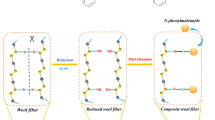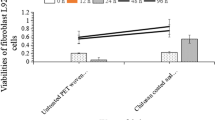Abstract
In this research, chitosan-poly(propylene)imine dendrimer hybrid (CS-PPI) was applied to wool fabrics; and weight gain and antibacterial properties of the grafted wool fabric by CS-PPI were investigated. A response surface methodology employed for optimization of the important factors such as pH, processing time, and CS-PPI and cross-linking agent (CA) concentrations. The physical properties showed sensible changes regardless of weight gain. The maximum weight gain was obtained when the wool fabrics were treated with pH 5, processing time 24 h, CS-PPI 20 %(owf) and CA 5 % over weight of fiber (owf). Scanning electron microscopy analysis showed the presence of foreign particles determinedly fixed to the surface of the wool fabric. Fourier transform infrared spectroscopy and differential scanning colorimetry revealed the grafting of CS-PPI onto wool fabric by forming novel chemical bonds between the wool and CS-PPI molecules. The treated wool fabrics showed broad-spectrum antimicrobial activity against gram-positive and gram-negative bacteria. Antimicrobial activities of the treated wool by CS-PPI at a concentration of 20 % over weight of fiber (owf) demonstrated 100 % bacterial growth inhibition, which was preserved more than 84 % even after being washed in 12 various conditions repeatedly. The grafted wool fabrics have antibacterial potential due to the antibacterial property of CS-PPI molecules. The mechanism of CS-PPI grafting onto wool fabric using CA was proposed. The findings of this study support the potential production of the new environmentally friendly textile fibers.









Similar content being viewed by others
References
Schindler WD, Hauser PJ (2004) Chemical finishing of textile. Woodhead publishing, UK
Purwar R, Joshi M (2004) Recent developments in antimicrobial finishing of textiles: a review. AATCC Rev 4:22–26
Roberts GA, Wood FA (2001) A study of the influence of structure on the effectiveness of chitosan as an anti-felting treatment for wool. J Biotechnol 89:297–304
Gao Y, Cranston R (2008) Recent advances in antimicrobial treatment of textiles. Text Res J 78:60–72
Lim SH, Hudson SM (2004) Application of a fiber-reactive chitosan derivative to cotton fabric as an antimicrobial textile finish. Carbohyd Polym 56:227–234
Pascual E, Julia MR (2001) The role of chitosan in wool finishing. J Biotechnol 89:289–296
Roberts GAF (1992) Chitin chemistry. Palgrave Macmillan, London
Zamani A, Taherzadeh MJ (2012) Production of superabsorbents from fungal chitosan. Iran Polym J 21:845–853
Hasanzadeh Kafshgari M, Khorram M, Mansouri M, Samimi A, Osfouri S (2012) Preparation of alginate and chitosan nanoparticles using a new reverse micellar system. Iran Polym J 21:99–107
El-tahlawy KF, El-bendary MA, Elhendawy AG, Hudson SM (2005) The antimicrobial activity of cotton fabrics treated with different crosslinking agents and chitosan. Carbohyd Polym 60:421–430
Hsieh SH, Huang ZK, Huang ZZ, Tseng ZS (2004) Antimicrobial and physical properties of woolen fabrics cured with citric acid and chitosan. J Appl Polym Sci 94:1999–2007
Kim YH, Nam CW, Choi JW, Jang J (2003) Durable antimicrobial treatment of cotton fabrics using N-(2-Hydroxy)propyl-3-trimethylammonium chitosan chloride and polycarboxylic acids. J Appl Polym Sci 88:1567–1572
Sashiwa H, Aiba S (2004) Chemically modified chitin and chitosan as biomaterials. Prog Polym Sci 29:887–908
Mourya VK, Inamdar NN (2008) Chitosan-modifications and applications: opportunities galore. React Funct Polym 68:1013–1051
Alves NM, Manoa JF (2008) Chitosan derivatives obtained by chemical modifications for biomedical and environmental applications. Int J Biol Macromol 43:401–414
Burkinshaw SM, Froehling PE, Mignanelli M (2002) The effect of hyperbranched polymers on the dyeing of polypropylene fibres. Dyes Pigments 53:229–235
Froehling PE (2001) Dendrimers and dyes-a review. Dyes Pigments 48:187–195
Vogtle F, Richard G, Werner N (2009) Dendrimer chemistry. Wiley-VCH, Weinheim
Zhang J, Zhang D, Zhang A, Jia Z, Jia Z, Jia D (2013) Dendritic polyamidoamine-grafted halloysite nanotubes for fabricating toughened epoxy composites. Iran Polym J 22:501–510
Choi YS, Cho TS, Kim JM, Han SW, Kim SK (2006) Amine terminated G-6 PAMAM dendrimer and its interaction with DNA probed by hoechst 33258. Biophys Chem 121:142–149
Sashiwa H, Kawasaki N, Nakayama A, Muraki E, Yajima H, Yamamori N, Ichinose Y, Sunamoto J, Aiba S (2003) Chemical modification of chitosan. Part 15: synthesis of novel chitosan derivatives by substitution of hydrophilic amine using N-carboxyethylchitosan ethyl ester as an intermediate. Carbohyd Res 338:557–561
Sadeghi Kiakhani M, Arami M, Gharanjig K (2013) Dye removal from colored textile wastewater using chitosan-PPI dendrimer hybrid as a biopolymer: optimization, kinetic and isotherm studies. J Appl Polym Sci 127:2607–2619
Ravikumar K, Krishnan S, Ramalingam S, Balu K (2007) Optimization of process variables by the application of response surface methodology for dye removal using a novel adsorbent. Dyes Pigments 72:66–74
Sadri Moghaddam S, Alavi Moghaddam MR, Arami M (2010) Coagulation/flocculation process for dye removal using sludge from water treatment plant: optimization through response surface methodology. J Hazard Mater 175:651–657
Rinaudo M (2006) Chitin and chitosan: properties and applications. Prog Polym Sci 31:603–632
Ranjbar-Mohammadi M, Arami M, Bahrami H, Mazaheri F, Mahmoodi NM (2010) Grafting of chitosan as a biopolymer onto wool fabric using anhydride bridge and its antibacterial property. Colloids Surf B: Biointerf 76:397–403
Davarpanah S, Mahmoodi NM, Arami M, Bahrami H, Mazaheri F (2009) Environmentally friendly surface modification of silk fiber: chitosan grafting and dyeing. Appl Surf Sci 255:4171–4176
Kumar MNVR (2000) A review of chitin and chitosan applications. React Funct Polym 46:1–27
Chung YC, Su YP, Chen CC, Jia G, Wang HL, Wu JC, Lin JG (2004) Relationship between antibacterial activity of chitosans and surface characteristics of cell wall. Acta Pharmacolo Sin 25:932–936
Giri Dev VR, Venugopal J, Sudha S, Deepika G, Ramakrishna S (2009) Dyeing and antimicrobial characteristics of chitosan treated wool fabrics with henna dye. Carbohyd Polym 75:646–650
Author information
Authors and Affiliations
Corresponding author
Rights and permissions
About this article
Cite this article
Sadeghi-Kiakhani, M., Arami, M. & Gharanjig, K. Application of a biopolymer chitosan-poly(propylene)imine dendrimer hybrid as an antimicrobial agent on the wool fabrics. Iran Polym J 22, 931–940 (2013). https://doi.org/10.1007/s13726-013-0193-8
Received:
Accepted:
Published:
Issue Date:
DOI: https://doi.org/10.1007/s13726-013-0193-8




